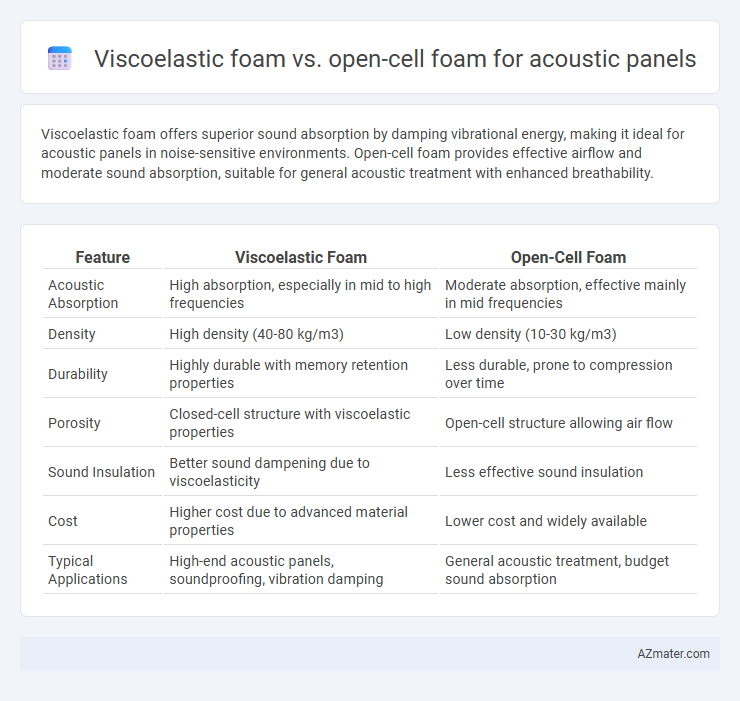Viscoelastic foam offers superior sound absorption by damping vibrational energy, making it ideal for acoustic panels in noise-sensitive environments. Open-cell foam provides effective airflow and moderate sound absorption, suitable for general acoustic treatment with enhanced breathability.
Table of Comparison
| Feature | Viscoelastic Foam | Open-Cell Foam |
|---|---|---|
| Acoustic Absorption | High absorption, especially in mid to high frequencies | Moderate absorption, effective mainly in mid frequencies |
| Density | High density (40-80 kg/m3) | Low density (10-30 kg/m3) |
| Durability | Highly durable with memory retention properties | Less durable, prone to compression over time |
| Porosity | Closed-cell structure with viscoelastic properties | Open-cell structure allowing air flow |
| Sound Insulation | Better sound dampening due to viscoelasticity | Less effective sound insulation |
| Cost | Higher cost due to advanced material properties | Lower cost and widely available |
| Typical Applications | High-end acoustic panels, soundproofing, vibration damping | General acoustic treatment, budget sound absorption |
Introduction to Acoustic Panels
Acoustic panels made from viscoelastic foam offer superior sound absorption due to their dense, viscoelastic properties that dissipate sound waves effectively, reducing echo and noise in various environments. Open-cell foam, characterized by its porous structure, allows air to pass through, providing excellent sound diffusion and absorption, particularly in mid to high-frequency ranges. Both materials enhance acoustic performance, but viscoelastic foam excels in low-frequency noise reduction while open-cell foam is favored for broad-spectrum sound control in acoustic panel applications.
Understanding Viscoelastic Foam
Viscoelastic foam, known for its high-density polymer structure, exhibits superior sound absorption by dissipating vibrational energy and reducing noise across a broad frequency range. Unlike open-cell foam, which relies on porous air pockets to trap sound waves, viscoelastic foam combines elasticity and viscosity, allowing it to dampen impact noise and airborne sound more effectively. This unique combination makes viscoelastic foam an optimal choice for acoustic panels in environments requiring enhanced noise control and vibration reduction.
Characteristics of Open-cell Foam
Open-cell foam used in acoustic panels is characterized by its porous structure, which allows sound waves to penetrate and dissipate effectively, enhancing noise absorption across a broad frequency range. This foam type features interconnected cells that provide breathability and flexibility, making it lightweight and adaptable for various acoustic applications. Its ability to reduce echo and reverberation while maintaining air flow distinguishes open-cell foam from denser options like viscoelastic foam.
Sound Absorption Properties
Viscoelastic foam exhibits superior sound absorption due to its dense, slow-recovery cellular structure that effectively traps and dissipates sound waves across a broad frequency range. In contrast, open-cell foam features a porous, breathable matrix that excels in absorbing mid to high-frequency sounds but may perform less efficiently at lower frequencies. The enhanced viscoelastic properties result in improved damping and vibration control, making it a preferred choice for acoustic panels targeting complex sound environments.
Noise Reduction Coefficient (NRC) Comparison
Viscoelastic foam typically exhibits higher Noise Reduction Coefficient (NRC) values ranging from 0.6 to 0.85, indicating superior sound absorption compared to open-cell foam, which generally has NRC values between 0.4 and 0.7. The viscoelastic properties allow this foam to dissipate sound energy more effectively by converting acoustic vibrations into heat, enhancing noise reduction performance in acoustic panels. Open-cell foam, while effective in absorbing mid to high-frequency sounds, may underperform in low-frequency noise absorption compared to viscoelastic foam.
Durability and Longevity
Viscoelastic foam, known for its higher density and memory properties, offers superior durability and maintains acoustic performance longer compared to open-cell foam, which is more prone to compression and degradation over time. Open-cell foam, while effective for sound absorption due to its porous structure, typically deteriorates faster under repeated stress and environmental exposure. Choosing viscoelastic foam for acoustic panels ensures extended longevity and consistent soundproofing efficiency in environments with frequent use or fluctuating conditions.
Fire Resistance and Safety
Viscoelastic foam demonstrates superior fire resistance compared to open-cell foam, due to its dense, slow-burning composition that resists ignition and reduces toxic smoke emissions. Open-cell foam, while offering excellent sound absorption, is typically more flammable and may require additional fire retardant treatments to meet safety standards. Fire safety compliance for acoustic panels often favors viscoelastic foam in environments with stringent regulations such as educational or commercial buildings.
Installation and Maintenance
Viscoelastic foam offers superior sound absorption with a dense structure, requiring careful handling during installation to avoid compression damage, while open-cell foam is lightweight and easier to cut and fit into various panel shapes. Maintenance for viscoelastic foam involves occasional dusting with a soft brush to preserve its integrity, whereas open-cell foam may need more frequent cleaning due to its porous surface attracting dust and debris. Both materials benefit from a dry, well-ventilated environment to prevent moisture buildup, but viscoelastic foam typically demonstrates greater resilience to long-term wear in acoustic applications.
Cost-effectiveness and Value
Viscoelastic foam offers superior sound absorption and durability but comes at a higher price compared to open-cell foam, making it a premium choice for acoustic panels. Open-cell foam provides a more affordable solution with effective noise reduction, suitable for budget-conscious projects while maintaining reasonable performance. Evaluating long-term value, viscoelastic foam's enhanced density and longevity often justify its initial investment in environments demanding high acoustic precision.
Best Applications for Each Foam Type
Viscoelastic foam offers superior sound absorption and vibration damping, making it ideal for high-noise environments such as recording studios, theaters, and industrial settings requiring precise acoustic control. Open-cell foam excels in lightweight, breathable acoustic panels best suited for office partitions, classrooms, and residential spaces where moderate sound diffusion and air permeability are desired. Choosing the right foam depends on balancing acoustic performance with environmental airflow and structural requirements.

Infographic: Viscoelastic foam vs Open-cell foam for Acoustic panel
 azmater.com
azmater.com